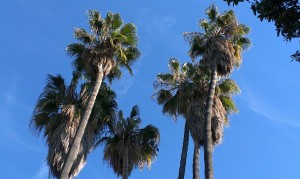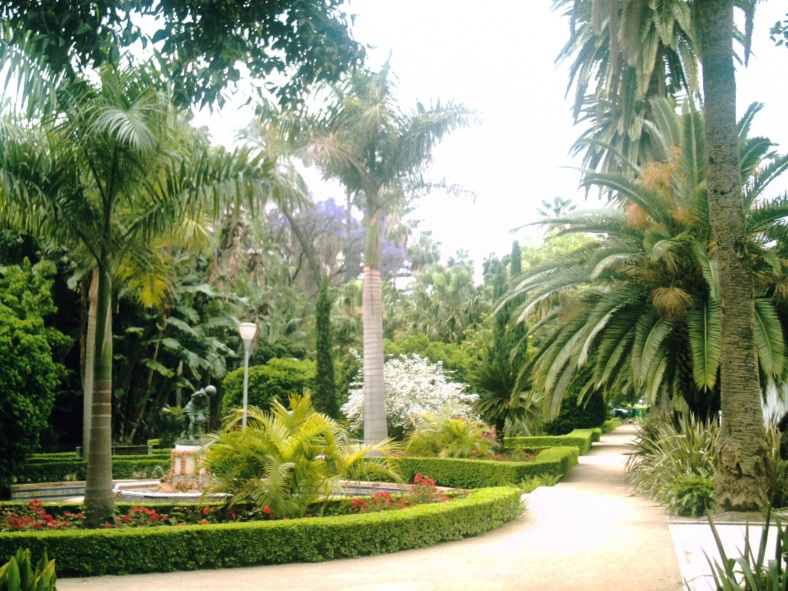LOCATION & DESCRIPTION
The Mediterranean climatic zone. A public park located in a harbour area in the heart of the city of Malaga, Andalucia, southern Spain. Sheltered by mountains to the north and warmed by the sea to the south, this area of reclaimed land benefits from a priveleged microclimate which has enabled it to support a wide range of mediterranean, sub tropical and tropical plantings. It has been variously described as being amongst the 20 best parks in Spain, and amongst the “third tier” of important botanic gardens in Europe. Also, as a garden de las cuatro estaciones (of the four seasons)De los cinco continentes (of the five continents) and as El parque que surgio del mar (the park which emerged from the sea).
The following two Youtube videos offer a nice introduction to the Parque and it’s history. The first was made through the excellent Malaga tourist office initiative “Loving Malaga”
And the second is a stylish piece by a Spanish holiday company, some of it based on information provided by this blog.
The Parque occupies a strategic place in the heart of the city centre, forming one of Malaga’s main urban arteries. The 670m long stretch runs alongside the Paseo del Parque main road, which divides it into two distinct areas, a larger banda exterior (33,200 sq. metres) and a smaller, triangular shaped banda interior ( 5,300 sq. metres). At its western end lies the Plaza de la Marina, a meeting point for two other main iconic shopping and tourist streets of Malaga, the Alameda Principal and Calle Larios. At its eastern end, beyond the bullring and the lighthouse on the headland, is the sweeping seafront Paseo Maritimo Pablo Picasso.
The travel website Gardenvisit (amongst others) provides a suitable aerial map & satellite view. http://www.gardenvisit.com/garden/paseo_del_parque .
The city’s AC Mariott hotel provides some stunning views of the Parque and the city from it’s 15th floor restaurant (see below). This is accessible to the public, but it’s worth checking the opening times.

…And the interpretation centre” located at the city’s hilltop castle also provides the visitor with an excellent model representation of the area…
Thesedays the Parque is bordered to its south by a newly landscaped and impressively designed harbourside area, Muelle No. 2 and Muelle Uno (read all about these areas in the Palmera de las Sorpresas page on this blog) and by the Paseo de los Curas, another busy main road which separates the area from the harbour.
Here are some more general views of the area……
The longer, larger section “La banda exterior” ……
The smaller, inland triangular shaped section (“La banda interior”) across the road …..
Across the Paseo del Parque to the north and east are the attractive, newly renovated rose gardens, Los Jardines Pedro Luis Alonso. The Parque and these gardens together form a 44,700m sq. green zone in the heart of the city…
…..Which in turn lead to the hillside gardens, Los Jardines de la Puerta Oscura……
…..Located next to another recently landscaped zone, the steep paths leading up to the city’s Alcazaba and Castillo, both of which are well worth a visit and provide sweeping views of the area below …
PLANTING AND DESIGN.
Constructed and landscaped over 100 years ago, on land reclaimed between a city and its harbour, the Parque is a classic example in garden design terms of how to overcome a narrow linear area, to create a feeling of space and curiosity for the visitor. The plantings are set out in geometrically shaped, rounded and sometimes symetrical borders, and the use of curved paths, island beds, focal points and tempting vistas, with patios and fountains softened by planting create the illusion of making the Parque seem much bigger.As famous local writer Jose Antonio del Cañizo has highlighted in his various essays on the garden, this enables the tourist to choose several “journeys of discovery” throughout.
Since the redevelopment also, the open, enhanced entrances from the upper and lower walkways offer even more inviting glimpses into the dense green planting of the area, and the steps, gangways and pedestrian crossings enable much easier access through to the harbour.
Writing in “The Mediterranean Gardener” author Hugo Latymer argues that whilst English gardens are perhaps all about individual plants and their characteristics, Mediterranean gardening is more about “structure over content.” That’s to say, it’s all about the architectural use of plants to create an effect. The underplanting of specimen trees and shrubs in the Parque with repeated drifts of groundcover and block planting – Agapanthus, Aspidistra, Clivia, Dracaena, Hedera, Philodendron, Phormium, Tulbaghia, Strelitzia etc.- is typical of this tradition, and in garden design terms of course it also provides the area with a sense of unity and continuity. The visitor will find splashes of colour amidst the overwhelmingly green jungle of complementing leaf shapes, sizes and textures. Perhaps the biggest contrast is in winter when the many silver-grey barked deciduous forms of Celtis, Ceiba, and Platanus stand skeletal like against both the tropical foliage and the often clear blue Malaga sky.
However, Cañizo has also stated that it was the founding aim of the Parque to build up a collection of plants which would not just be ornamental, attractive and colourful throughout the seasons, but that would also be of great botanical and scientific interest to experts, tourists and citizens alike. In other words, “A living encylopedia” of the botanical world.
“….Es un museo natural y pujante, una enciclopedia hecha, no de paginas y tinta sino de savia y de follaje, un muestrario rico y exuberante de todo lo que la creacion ha inventado en cuanto a formas vegetales a armonias de copas y troncos y a variedad de tonos y matices.” Jose A. del Canizo.
La Luz (The Light)
Finally a note on something that the guidebooks may not mention. It’s worth following Cañizo’s further advice to visit the Parque at different seasons throughout the year, to truly appreciate the ever changing flower and foliage that the trees, shrubs and herbaceous plants have to offer. However I’d like to suggest to the tourist that it is also well worth viewing the area at different times during the day, as the light in Malaga is reknowned. It changes by the hour, not just by the season, and really is something to be appreciated by the visitor to this city. Quite apart from all of the impressive botanical specimens, the attractive patios and monuments and all that the area has to offer, above everything one could argue that it’s actually the light that really defines this Parque, from the sharp early morning sun through to the heat of noon, and on to the shadows and subtlety of evening, creating a different atmosphere on each occassion.


















